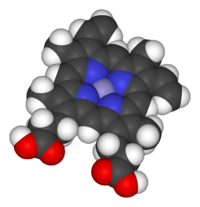
Photo from wikipedia
Heme is an active center in many proteins. Here we explore computationally the role of heme in protein folding and protein structure. We model heme proteins using a hybrid model… Click to show full abstract
Heme is an active center in many proteins. Here we explore computationally the role of heme in protein folding and protein structure. We model heme proteins using a hybrid model employing the AWSEM Hamiltonian, a coarse-grained forcefield for the protein chain along with AMBER, an all-atom forcefield for the heme. We carefully designed transferable force fields that model the interactions between the protein and the heme. The types of protein–ligand interactions in the hybrid model include thioester covalent bonds, coordinated covalent bonds, hydrogen bonds, and electrostatics. We explore the influence of different types of hemes (heme b and heme c) on folding and structure prediction. Including both types of heme improves the quality of protein structure predictions. The free energy landscape shows that both types of heme can act as nucleation sites for protein folding and stabilize the protein folded state. In binding the heme, coordinated covalent bonds and thioester covalent bonds for heme c drive the heme toward the native pocket. The electrostatics also facilitates the search for the binding site. Supplementary Information The online version contains supplementary material available at 10.1007/s10867-021-09596-3.
Journal Title: Journal of Biological Physics
Year Published: 2022
Link to full text (if available)
Share on Social Media: Sign Up to like & get
recommendations!